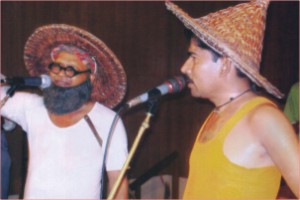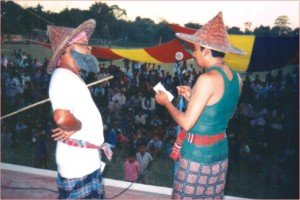| Journey Through Bangladesh
From Chapainawabganj
Gombhira And Folk Culture
Entertainment is not always about “getting a good laugh out of it”. Such is this ancient and nearly lost form of stage performance through dialogue and song. Society has always been thirsty for knowledge of what is actually going on around them, and people have always held interests in discussing the matters. This form of impromptu dialogue and song performance on stage helps ignite fires for the discussions that society ponders upon.
Rabiul Hasan
Bangladesh has a very rich folk-cultural background, a part of which is Gombhira. Gombhira is an important part of folk literature of the country, which conveys deep morality in a humorous manner. It is supposed that Gombhira first came into being about 1500 years ago. Originally, it was completely devoted to Shivas, a Hindu god. As such Gombhira was called “Sivas Gazon” or “Adder Gombhira”. Pala Gombhira was another form of Gombhira. The most important problems and critical issues were raised before Shivas through Gombhira, and solutions were sought from the God.
 At the outset of the 20th century, Gombhira was no longer confined by religion, and Shiva was replaced by man himself. So the subject matter of Gombhira changed from religious to social and political problems of modern times. Gombhira tends to bring to light the incongruities and inconsistencies of the society. So it becomes a voice of protest which brings together the views of general people and it talks against irregularities and corruptions present in the society. At the outset of the 20th century, Gombhira was no longer confined by religion, and Shiva was replaced by man himself. So the subject matter of Gombhira changed from religious to social and political problems of modern times. Gombhira tends to bring to light the incongruities and inconsistencies of the society. So it becomes a voice of protest which brings together the views of general people and it talks against irregularities and corruptions present in the society.
Gombhira first flourished in the district of Maldah, now in Chapainawabgonj. According to Gombhira Researcher Dr. Proddut Ghos, Sheikh Safiur Rahman alias Sufi Master and Solaiman Moktar were the two founders of Gombhira. Sheikh Sofiur Rahman was a Postmaster of Maldah town during British rule. Safi Master came from Rohonpur Bazar of Gomostapur Upazila under Chapainawabgonj and Solaiman Moktars residence was at Chapainawabgonj town.
The dialect of Chapainawabgonj is the very tone of Gombhira. This dialect gives Gombhira a distinct tone or feeling, making it more attractive. Ghombhira is essentially a drama in which a story is presented through two main characters an elderly person and a youngster. Formerly, a song was the main ingredient of Gombhira, but over time, dialogue has taken precedence. So Gombhira is both a folk song and a drama. Sotish Gupta and Biswanath Pandit, two researchers of West Bengal in India, opined that Gombhira is the mixture of Alkap, Ramprosadi and Kirton.
Gombhira does not deal with stories that usually amuse the masses, which is the case with circus or jatrapala, rather it is the artistic presentation of a serious matter by Nana (grandfather) and Nati (grandson) through their gesticulation and dialogue. The grandson is the representative of the destitute. His speech is full of humour but there is a moral underneath.
The grandfather is an old man, also a poor farmer. He puts on a shabby shirt (genji), has a full beard, a hat (mathal) and needs a stick to support his stature. The nati (grand son) also wears a colourful waistcloth (lungi), a shirt, a towel (gamcha) around the waist and a hat on his head. The dress of nana and nati represent the traditional dress of rural Bengali folk.
 The beginning of Gombhira presentation is very interesting. One of the dohars request Nati who is regarded as a Gadha (a fool) to come to the stage. The grandson (nati) appears on the stage and starts the show with a song dealing with the sadness of his celibacy. Just at that moment Nana appears on the stage with the stick in his hand raised to attack his Nati for being disobedient. The Gombhira is now in full swing. It is also interesting to note that the dialogues used by the Nana and the Nati are not prepared beforehand in writing. The script does not include prepared dialogue, but is a story that they bring to life with their own words every time that they are on stage. They just speak from their presence of mind. The beginning of Gombhira presentation is very interesting. One of the dohars request Nati who is regarded as a Gadha (a fool) to come to the stage. The grandson (nati) appears on the stage and starts the show with a song dealing with the sadness of his celibacy. Just at that moment Nana appears on the stage with the stick in his hand raised to attack his Nati for being disobedient. The Gombhira is now in full swing. It is also interesting to note that the dialogues used by the Nana and the Nati are not prepared beforehand in writing. The script does not include prepared dialogue, but is a story that they bring to life with their own words every time that they are on stage. They just speak from their presence of mind.
 The musical instruments used in Gombhira are Dholok and Juri. About 80 years back, Gopal Das, Horimohon Kundu, Sorat Das and Sheikh Safiur Rahman added the Harmonium to Gombhira and about 50 years back, a flute was included as well. Presently, keyboards are also used sometimes. The musical instruments used in Gombhira are Dholok and Juri. About 80 years back, Gopal Das, Horimohon Kundu, Sorat Das and Sheikh Safiur Rahman added the Harmonium to Gombhira and about 50 years back, a flute was included as well. Presently, keyboards are also used sometimes.
Besides Chaipainawabgonj, Gombhira is cultivated and practiced at Rajshahi. There are four major groups (gosthi) of Gombhira at Chapainawabgonj, the place where the art originated. Chapai Gombhira is one of the four, in which Mahbubul Alam and Faijur Rahman Mani play the role of Nana (grandfather) and Nati (grandson) respectively. It is a matter of great regret that no folklore institute has been yet established at Chapainawabgonj to cultivate folk songs like Gombhira and others. If institutionally patronized, Gombhira and other folk songs of Chapainawabgonj will have a proper footing and they will be able to flourish to mass mediums. Bangla Academy, Bangladesh Shilpakala Academy, the Asiatic Society and other societies and charitable organizations can play a positive role in reaching that goal.
Gombhira, at present, is an art form in decline, although it is widely staged in many schools, colleges, universities and different folk-art groups. Gombhira was very popular in the rural areas but due to globalization and spread of satellite television entertainment, the tradition is losing its appeal day by day, said Gombhira performer Nana Mahbubul Alam and Nati Faizur Rahman Mani of Chapai Gombhira.
Saidur Rahman, a troop leader, said, “Gombhira artistes are facing acute financial crisis, the market does not offer proper support from any corner”. “Gombhira is a very effective medium which can help create awareness among the general mass of the country. No other cultural medium by itself is as strong”, said Dr. Mazharul Islam Toru, a Researcher of Gombhira and an Associate Professor in the Department of Bengali Literature of Chapainawabagnj Government College.
Copyright
(R) thedailystar.net 2009
|

 At the outset of the 20th century, Gombhira was no longer confined by religion, and Shiva was replaced by man himself. So the subject matter of Gombhira changed from religious to social and political problems of modern times. Gombhira tends to bring to light the incongruities and inconsistencies of the society. So it becomes a voice of protest which brings together the views of general people and it talks against irregularities and corruptions present in the society.
At the outset of the 20th century, Gombhira was no longer confined by religion, and Shiva was replaced by man himself. So the subject matter of Gombhira changed from religious to social and political problems of modern times. Gombhira tends to bring to light the incongruities and inconsistencies of the society. So it becomes a voice of protest which brings together the views of general people and it talks against irregularities and corruptions present in the society.  The beginning of Gombhira presentation is very interesting. One of the dohars request Nati who is regarded as a Gadha (a fool) to come to the stage. The grandson (nati) appears on the stage and starts the show with a song dealing with the sadness of his celibacy. Just at that moment Nana appears on the stage with the stick in his hand raised to attack his Nati for being disobedient. The Gombhira is now in full swing. It is also interesting to note that the dialogues used by the Nana and the Nati are not prepared beforehand in writing. The script does not include prepared dialogue, but is a story that they bring to life with their own words every time that they are on stage. They just speak from their presence of mind.
The beginning of Gombhira presentation is very interesting. One of the dohars request Nati who is regarded as a Gadha (a fool) to come to the stage. The grandson (nati) appears on the stage and starts the show with a song dealing with the sadness of his celibacy. Just at that moment Nana appears on the stage with the stick in his hand raised to attack his Nati for being disobedient. The Gombhira is now in full swing. It is also interesting to note that the dialogues used by the Nana and the Nati are not prepared beforehand in writing. The script does not include prepared dialogue, but is a story that they bring to life with their own words every time that they are on stage. They just speak from their presence of mind. The musical instruments used in Gombhira are Dholok and Juri. About 80 years back, Gopal Das, Horimohon Kundu, Sorat Das and Sheikh Safiur Rahman added the Harmonium to Gombhira and about 50 years back, a flute was included as well. Presently, keyboards are also used sometimes.
The musical instruments used in Gombhira are Dholok and Juri. About 80 years back, Gopal Das, Horimohon Kundu, Sorat Das and Sheikh Safiur Rahman added the Harmonium to Gombhira and about 50 years back, a flute was included as well. Presently, keyboards are also used sometimes.